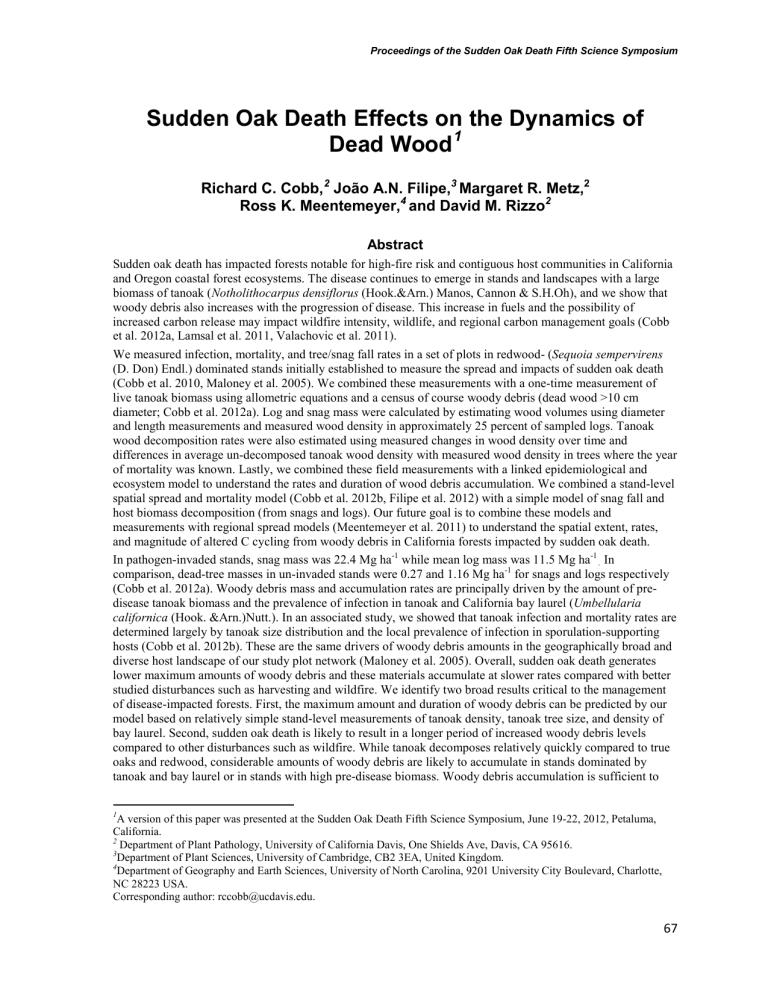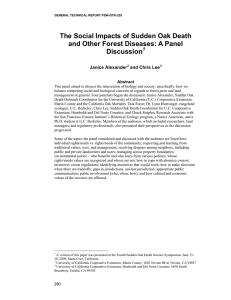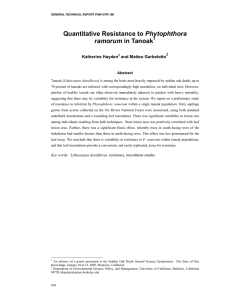Sudden Oak Death Effects on the Dynamics of Dead Wood

Proceedings of the Sudden Oak Death Fifth Science Symposium
Sudden Oak Death Effects on the Dynamics of
Dead Wood
Richard C. Cobb,
João A.N. Filipe,
Ross K. Meentemeyer,
4
3
Margaret R. Metz, and David M. Rizzo
2
2
Abstract
Sudden oak death has impacted forests notable for high-fire risk and contiguous host communities in California and Oregon coastal forest ecosystems. The disease continues to emerge in stands and landscapes with a large biomass of tanoak ( Notholithocarpus densiflorus (Hook.&Arn.) Manos, Cannon & S.H.Oh), and we show that woody debris also increases with the progression of disease. This increase in fuels and the possibility of increased carbon release may impact wildfire intensity, wildlife, and regional carbon management goals (Cobb et al. 2012a, Lamsal et al. 2011, Valachovic et al. 2011).
We measured infection, mortality, and tree/snag fall rates in a set of plots in redwood- ( Sequoia sempervirens
(D. Don) Endl.) dominated stands initially established to measure the spread and impacts of sudden oak death
(Cobb et al. 2010, Maloney et al. 2005). We combined these measurements with a one-time measurement of live tanoak biomass using allometric equations and a census of course woody debris (dead wood >10 cm diameter; Cobb et al. 2012a). Log and snag mass were calculated by estimating wood volumes using diameter and length measurements and measured wood density in approximately 25 percent of sampled logs. Tanoak wood decomposition rates were also estimated using measured changes in wood density over time and differences in average un-decomposed tanoak wood density with measured wood density in trees where the year of mortality was known. Lastly, we combined these field measurements with a linked epidemiological and ecosystem model to understand the rates and duration of wood debris accumulation. We combined a stand-level spatial spread and mortality model (Cobb et al. 2012b, Filipe et al. 2012) with a simple model of snag fall and host biomass decomposition (from snags and logs). Our future goal is to combine these models and measurements with regional spread models (Meentemeyer et al. 2011) to understand the spatial extent, rates, and magnitude of altered C cycling from woody debris in California forests impacted by sudden oak death.
-1 In pathogen-invaded stands, snag mass was 22.4 Mg ha -1 while mean log mass was 11.5 Mg ha comparison, dead-tree masses in un-invaded stands were 0.27 and 1.16 Mg ha -1
.
In
for snags and logs respectively
(Cobb et al. 2012a). Woody debris mass and accumulation rates are principally driven by the amount of predisease tanoak biomass and the prevalence of infection in tanoak and California bay laurel ( Umbellularia californica (Hook. &Arn.)Nutt.). In an associated study, we showed that tanoak infection and mortality rates are determined largely by tanoak size distribution and the local prevalence of infection in sporulation-supporting hosts (Cobb et al. 2012b). These are the same drivers of woody debris amounts in the geographically broad and diverse host landscape of our study plot network (Maloney et al. 2005). Overall, sudden oak death generates lower maximum amounts of woody debris and these materials accumulate at slower rates compared with better studied disturbances such as harvesting and wildfire. We identify two broad results critical to the management of disease-impacted forests. First, the maximum amount and duration of woody debris can be predicted by our model based on relatively simple stand-level measurements of tanoak density, tanoak tree size, and density of bay laurel. Second, sudden oak death is likely to result in a longer period of increased woody debris levels compared to other disturbances such as wildfire. While tanoak decomposes relatively quickly compared to true oaks and redwood, considerable amounts of woody debris are likely to accumulate in stands dominated by tanoak and bay laurel or in stands with high pre-disease biomass. Woody debris accumulation is sufficient to
1 A version of this paper was presented at the Sudden Oak Death Fifth Science Symposium, June 19-22, 2012, Petaluma,
California.
2
3
4
Department of Plant Pathology, University of California Davis, One Shields Ave, Davis, CA 95616.
Department of Plant Sciences, University of Cambridge, CB2 3EA, United Kingdom.
Department of Geography and Earth Sciences, University of North Carolina, 9201 University City Boulevard, Charlotte,
NC 28223 USA.
Corresponding author: rccobb@ucdavis.edu.
67
General Technical Report PSW-GTR-243 impact fire intensity (Valachovic et al. 2011) suggesting that fuels reduction treatments may be necessary in regions at risk of sudden oak death emergence or those already impacted by the disease.
Literature Cited
Cobb, R.C.; Meentemeyer, R.K.; and Rizzo, D.M. 2010.
Apparent competition in canopy trees determined by pathogen transmission rather than susceptibility. Ecology 91:327-333.
Cobb, R.C.; Chan, N.; Meentemeyer, R.K.; Rizzo, D.M. 2012a.
Common factors drive disease and coarse woody debris dynamics in forests impacted by sudden oak death. Ecosystems. 15: 242–255.
Cobb, R.C.; Filipe, J.A.N.; Meentemeyer, R.K.; Gilligan, C.A.; Rizzo, D.M. 2012b.
Ecosystem transformation by emerging infectious forest disease: loss of large tanoak from California forests. Journal of
Ecology. 100: 712–722.
Filipe, J.A.N.; Cobb, R.C.; Meentemeyer, R.K.; Lee, C.A.; Valachovic, Y.S.; Cook, A.R.; Rizzo, D.M.;
Gilligan, C.A. 2012.
Landscape epidemiology and control of pathogens with cryptic and long-distance dispersal: sudden oak death in northern California forests. PLoS Computational Biology. 8(1): e1002328. doi:10.1371/journal.pcbi.1002328.
Lamsal, S.; Cobb, R.C.;Meng, Q.; Rizzo, D.M.; Meentemeyer, R.K. 2011.
Density, carbon content, and spatial distribution of Phytophthora ramorum host populations in California and Oregon forests. Forest
Ecology and Management. 262: 989–998.
Maloney, P.E.; Lynch, S.C.; Kane, S.F.; Jensen, C.E.; Rizzo, D.M. 2005.
Establishment of an emerging generalist pathogen in redwood forest communities. Journal of Ecology. 93: 899–905.
Meentemeyer, R.K.; Cunniffe, N.J.; Cook, A.R.; Filipe, J.A.N.; Hunter, R.D.; Rizzo, D.M.; Gilligan, C.A.
2011.
Epidemiological modeling of invasion in heterogeneous landscapes, spread of sudden oak death in
California (1990-2030). Ecosphere. 2: art17.
Valachovic, Y.S.; Lee, C.A.; Scanlon. H.; Varner, J.M.;Glebocki, R.; Graham, B.D.; Rizzo, D.M. 2011.
Sudden oak death-caused changes to surface fuel loading and potential fire behavior in Douglas-fir-tanoak forests. Forest Ecology and Management. 261: 1973–1986.
68



